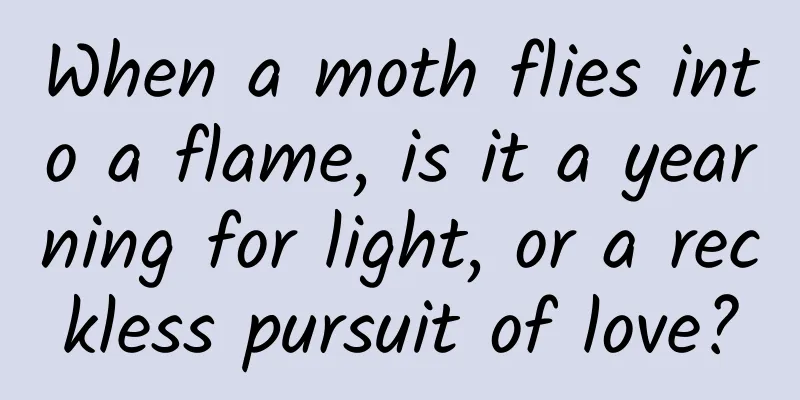When a moth flies into a flame, is it a yearning for light, or a reckless pursuit of love?

|
"A mysterious object appeared in the sky above the pharmaceutical factory. It was shaped like a stick and was flying at high speed. Is this strange phenomenon a flying dragon in the sky, or a different kind of UFO - a flying stick?" In June 2013, the "Science Approaches" program team broadcast a program called "The Mystery of Flying Sticks". The foreshadowing at the beginning made everyone think it was some extraordinary "UFO", but it turned out to be... a moth attracted by the camera. Image source: CCTV video screenshot Because the camera shutter speed is relatively slow and the moths fly relatively fast, they look like flying sticks in the surveillance video. However, this seems to confirm everyone's impression of moths - they have a special liking for light sources. So why do light sources have such a "fatal attraction" to moths? Mistaking the lights for the moon Speaking of moths, many people may think of an idiom in their minds - moths flying into the fire. The image of moths flying into the fire is reflected in many classics and poems. For example, in the 27th chapter of Journey to the West, Tang Monk said: "When sweeping the floor, I am afraid of hurting the lives of ants, so I protect the moths in the lamp with gauze"; and the Tang poem "Behind the Door" mentioned: "The lamp gathers the shadows of moths, and the window pins burst into snow marks"; even in the eyes of some literati and poets, moths flying into the fire have become a symbol of positive energy that pursues light. Moths to flame, Image source: blogs.brandeis.edu But apart from literary and artistic techniques, we also need to know that seeking benefits and avoiding harm is the nature of living things, and fire is undoubtedly dangerous to living things. Will moths really give up their lives for the so-called light? The answer is obviously no. Although scientists still haven't figured out why moths fly into fire, they have found many possible explanations for why moths are attracted to light. The most well-known of these is probably the "moonlight navigation hypothesis." In the 1930s, German entomologist von Buddenbrook proposed that as a nocturnal animal, moths might rely on the moon to navigate and determine their direction when flying at night. Image source: Reference [1] This is not difficult to understand, because the moon is very far away from the earth and can be regarded as a very distant light source. When the moonlight falls on the earth, it can be regarded as parallel light. As long as the moth flies at a fixed angle to the moonlight (such as θ in the picture above), it can ensure that it flies forward in a straight line. However, this navigation solution will have certain problems when facing point light sources that are relatively close, such as candlelight or street lights. Because the distance is very close, the light from the light source spreads in all directions in a radial manner. If the moth still flies at a fixed angle at this time, its flight trajectory will bend toward the light source, and eventually it will approach the light source in a circling posture, and either hit the street lamp or die in the fire. Image source: Reference [1] Such a wonderful explanation that conforms to mathematical logic was widely recognized once it was proposed. In order to prove that this hypothesis is indeed reliable, scientists once again conducted a series of experiments. In 1978, Robin Baker and others from the University of Manchester in the UK published a research paper in the journal Nature. In this study, they recorded the flight path of moths through an ingenious design. In the study design, when the moon was not obscured, the moths were indeed able to fly in a straight line, but when the moon was obscured, or the moths' eyes were covered, they could not fly in a straight line. After further exploring the effect of light on moths, they found that when light is present, moths will change their flight trajectory according to the location of the light. Not only that, the height and size of the light source also have an important impact on moths. When the light source is high, it is easy to attract moths from far away. From the above experiment, it is not difficult to see the impact of light sources on moths, but there is no consensus in academia as to whether the reason behind moths flying into fire is because they mistake the light for the moon. At least, some scientists believe that moths flying into fire may also be due to love. Love chasing light more than love your partner? Fabre recorded such an interesting phenomenon in his book "The Insect Life": If female moths and candlelight are placed in the same room, most male moths will ignore the existence of the females and still fly towards the candlelight, performing a story of moths flying into fire. You know, the top priority in the life of a male moth is to mate with a female and leave his own offspring. Why do male moths make such a choice between the light source and the female's sex pheromones? Moths mating, Image source: inaturalist.org If the ultimate purpose of male moths traveling under the moonlight is to find females for mating, then the behavior of males still heading towards the light when the female is right in front of them is indeed difficult to explain using the "moonlight navigation hypothesis." In this regard, some scientists believe that in the eyes of male moths, the light source may be mistaken for a female moth, and this female moth is more attractive to male moths. This is not impossible. In the 1970s, Philip Callaghan proposed the "infrared hypothesis" of the attractiveness of light sources to moths. His point of view is that the sex pheromones of female moths will be affected by ultraviolet rays in the air and enter an excited state, emitting infrared light, which will be received by male moths. Lights can also emit infrared light of similar wavelengths, and the infrared light emitted by the light source is more intense. For male moths, this is like a super female moth, and of course they will flock to it. Although this hypothesis cannot perfectly explain the phenomenon of moths flying into fire, after all, female moths will also approach when they see the light, but it cannot completely rule out this possibility. In moths, there are indeed many species with gender differences in phototropism. For example, when using lights to lure gypsy moths, scientists found that the number of male moths attracted by the lights was far greater than that of females. This phenomenon has been found in many moth species. Image source: Reference [3] It is worth mentioning that whether moths fly into fire because of a failure of their navigation system or because they are attracted by "imaginary females", their phototaxis is not to seek death, but because human inventions have affected an instinct formed by moths during the evolution process. However, as time goes by, the power of evolution seems to be quietly changing all this. Evolutionary behavior under light pollution Let's think about another question. If the impact of artificial light on moths can lead to the evolution of moths, then will moths in cities and moths from rural areas that live under dark skies most of the time behave differently when faced with artificial light? I believe most people will give a positive answer. With the same question in mind, two biologists conducted a study to explore the possible impact of modern artificial lighting on the evolution of moths. The study was published in the journal Biology Letters in 2016. In this study, scientists tested the flight behavior of 1,048 ermine moths under light. They collected the larvae of the moths from different regions, including 320 from rural areas and 728 from light-polluted areas. The larvae were raised in the laboratory with 16 hours of light and 8 hours of darkness per day until they emerged as adults. Marten moth, Image source: Reference [4] Two to three days after eclosion, they were placed in a flight cage with a fluorescent tube on one side to observe their flight behavior under a light source. The results showed that the light source was significantly less attractive to moths from light-polluted areas than those from rural areas. Overall, moths from light-polluted areas showed 30 percent less flight behavior toward light sources than moths from rural areas, which seems to indicate that the species has evolved in response to light pollution, as predicted - away from artificial light. You can understand it this way: no matter how much you like a certain food, you won't want to eat it anymore if you eat too much of it. Similarly, these moths from light-polluted areas are exposed to light sources for a long time, so they are not so sensitive to light sources when they grow up. The researchers believe that this change should increase the reproductive success rate of these urban moths. After all, from previous studies we can conclude that the light source is less attractive to moths, and the moths' attention to their other half will increase relatively. But the researchers also believe that this success comes at a price: To avoid the lights, moths may fly less, so they won't pollinate as many flowers, and spiders and bats may not get enough moths as food. However, as long as they don’t die in the fire, what does this have to do with moths? References [1] Mohamed, AAA, Mohamed, YS, El-Gaafary, AA, & Hemeida, AM (2017). Optimal power flow using moth swarm algorithm. Electric Power Systems Research, 142, 190-206. [2] Baker, RR, & Sadovy, Y. (1978). The distance and nature of the light-trap response of moths. Nature, 276(5690), 818-821. [3] Cheng Wenjie, Zheng Xialin, Wang Pan, Lei Chaoliang, Wang Xiaoping. (2011). Sexual differences in insect phototropism and its influencing factors[J]. Chinese Journal of Applied Ecology. 22(12), 3351-3357. [4] Altermatt, F., & Ebert, D. (2016). Reduced flight-to-light behavior of moth populations exposed to long-term urban light pollution. Biology letters, 12(4), 20160111. This article is produced by Science Popularization China, produced by EVEE (School of Life Sciences, Peking University), and supervised by China Science Popularization Expo |
<<: Yellow flesh and black seeds, the most commonly eaten "papaya" is not actually papaya? !
>>: Can the Webb telescope find extraterrestrial life soon? Scientists are confident
Recommend
Tardigrades become the first animals to achieve quantum entanglement?
Tardigrades become the first animals to achieve q...
Tesla braked for no reason and then accelerated automatically. The owner called customer service and the driving record was remotely deleted
Recently, there have been frequent news reports a...
Beauty industry hot-selling course: Beauty industry account formula
Course Catalog ├──01、The beauty industry IP I inc...
Private Domain Operation: A Second Breakthrough Behind Traffic Anxiety
It is becoming increasingly difficult to attract ...
New research: Once this core organ ages, the functions of the whole body will "regress"
The liver is an important detoxification organ in...
Exclusive analysis: 4 ways to monetize mobile Internet! (Down)
Before the analysis, let me briefly explain my de...
HTML5 game performance is greatly improved, Egret Engine 1.5 is released
Recently, Egret Times released the latest generat...
Apple iOS 17 system hidden improvements: automatic clearing of SMS verification codes, sharing of AirTags, screen too close prompts, etc.
On June 6, at the WWDC 2023 developer conference ...
Pulse advertising analysis!
The purpose of advertising is to reduce communica...
SAIC's "Internet × New Energy" strategic upgrade extends to B-class vehicles to form full coverage
SAIC's "Internet × New Energy" strat...
There's nothing wrong with mushrooms growing on apples. These foods taste better when they're sick!
Some time ago, a netizen on Xiaohongshu posted a ...
What is the time and place for the return of Shenzhou 13 in 2022? Attached is the latest official news!
Shenzhou XIII is the sixth flight of the key techn...
Operations uncle: The circle of friends exploded! Let’s talk about why the constellation QR code of the Plato app can be all over the circle of friends overnight!
I'm sure all of you in your circle of friends...
Analysis of KFC’s Private Domain Operations
Recently, the "Pikachuk" meal toy launc...









